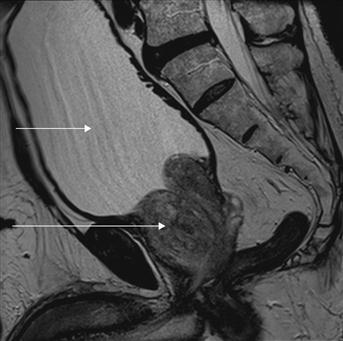Urinary Retention
Retention of urine may be acute, chronic or acute-on-chronic. Patients with acute retention present as surgical emergencies. Acute retention is the sudden inability to pass urine, with the presence of painful bladder. Chronic retention is the presence of an enlarged, painless bladder with or without difficulty in micturition.
History
Local
Check for a history of problems with micturition, e.g. difficulty in starting, poor stream, nocturia, frequency, dysuria. Is there any history of urinary tract infection, urethritis, ureteric colic (to suggest a stone which may have passed into the bladder and then impacted into the bladder neck or urethra) or haematuria? Is there a past history of prolonged catheterisation to suggest a urethral stricture? A history of trauma will be apparent. Has the patient fallen astride an object? Has trauma caused a pelvic fracture? Is the patient constipated, to suggest faecal impaction? A pregnant uterus will be obvious.
General
Postoperative acute retention is common, especially in elderly men. This may be due to anxiety, embarrassment, supine posture, pain, drugs, fluid overload or previous unrecognised prostatism, with minimal symptoms. After urological procedures, it may be due to blood clot in the bladder. Check for a history of neurological disease. Has the patient suffered spinal cord injury? Check the drug history.
Examination
Local
The patient may have a tender, palpable, painful bladder with sudden onset of retention. In acute retention, the bladder rarely extends far above the pubic symphysis. In chronic retention, the distended bladder is often painless and more markedly distended than in acute retention, often reaching to the umbilicus. With chronic retention, there may be overflow incontinence. Feel along the course of the urethra for a stone or stricture. Perform a digital rectal examination to check for prostatic hypertrophy or pelvic tumour. Following pelvic trauma with urethral injury, there will be a high ‘floating’ prostate on rectal examination. Check the urethral meatus for ulcer or stone. Examine the patient for signs of uraemia, which may be present with chronic retention.
General
Postoperative retention will be obvious. Occasionally it is difficult to palpate the bladder because of pain and guarding related to a surgical incision. Neurological causes of acute retention or those related to spinal trauma are often obvious. Carry out a full neurological examination.
General Investigations
■ FBC, ESR
Hb ↓ in chronic renal failure, tumours, haematuria. WCC ↑ infection. ESR ↑ malignancy and infection.
■ MSU
Microscopy. C&S for UTI. Cytology to confirm malignancy.
■ U&Es
Renal failure. Obstructive uropathy.
■ CXR
Pulmonary oedema (chronic renal failure). Possible tumour metastases.
■ US
Bladder size confirms diagnosis. Dilated upper urinary tract due to back pressure. Pregnant uterus.





